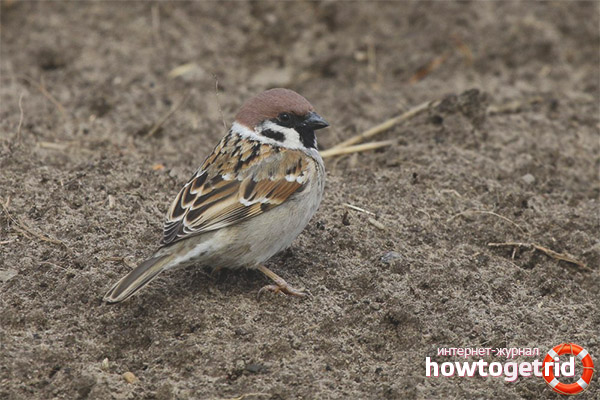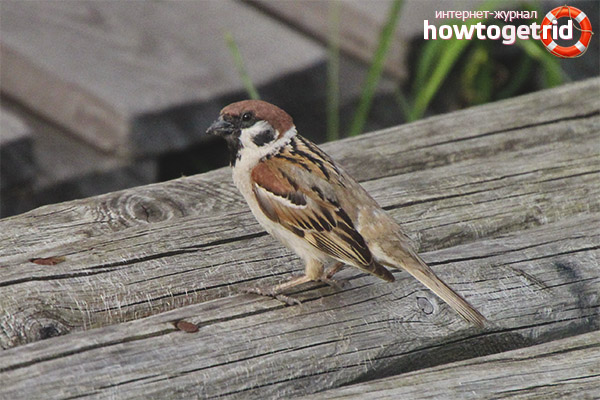The content of the article
Field sparrows are assigned to the sparrow family, respectively. They belong to the closest relatives of house birds. But by their natural features they are not so dependent on people, preferring to shun them. You can meet field representatives of the group on the outskirts of the city, as well as in sparsely populated areas or completely abandoned territories. It is important for them to have cereal crops nearby, as well as orchards or vineyards. By their natural characteristics, individuals prefer to live in bright areas, steppes and among shrubs.
Description
- The bird on the body does not differ in large dimensions. In length grows to a maximum of 16 cm. With a body weight of 30 g. (maximum value). If we compare this species of sparrows with house birds, we can say the following. They are not tied to human activity, and therefore can exist in uninhabited territories.
- Individuals of male and female gender are pigmented in the same tones. Regardless of the season of the year, this color will only be slightly modified. The upper part of the head is pigmented chestnut. Cheeks and upper feathers on wings are whitish. There is a distinct black spot on the cheeks.
- In the area behind the neck there is a so-called white necklace. It can be intermittent, with a chestnut tint. The neckline is famous for the presence of a black mark, which does not descend onto the chest. The upper part of the body is painted red with brown, oblong stripes are present on the pink.
- The area above the tail is buffy with a light brown tone. The lower part of the body is whitish, there are inclusions of an ocher shade. The same color goes to the side of the body. The wings are brownish, dark, with a characteristic border of light brown color. There is a whitish mark on the folds of the wings. The tail is brown-brown, its edges are painted buffy. The beak is pigmented in black, the irises are brown, the legs are beige and pink.
- Young growth in its color is rather faded. It has no black feathers; instead, there are brownish gray shades. The beak is also colored brown, the edges are yellowish, as well as the corners of the mouth. Field representatives differ from house sparrows in that the top of the head has a chestnut color. Individuals have black spots on their cheeks, and there is also no difference in gender.
- From other representatives of the passerine family, for example, individuals with a black brisket, the field sparrow is distinguished by a bright back. These birds have a unique feature of looking harmoniously with their miniature size and short cropped tail.
- As for the voice of these feathered relatives, their exclamations are somewhat reminiscent of the voice of house sparrows. But it is more sharp and sonorous, there is no softness. Briefly try to convey the exclamations, they sound like "stupid", "chip", "tsvi." These sounds can be alternated or pronounced separately.
Habitat
- Individuals are more common in our country. They live everywhere, but are rare in the Arctic belt. They are closer to the subarctic. As for the choice of landscape, they live from the taiga to the highlands. Found in arid steppes and deserts.
- Quickly adapt to various climatic conditions. By their natural numbers, there are more field sparrows than brownies. But this is due to the vast area in which these birds prefer to settle.
- Considering the accumulation of birds in cities, we can say that they live exclusively on the outskirts.They do not approach high-rise buildings, they do not occur in park areas and squares.
Lifestyle
- Settled birds, they do not like to wander from one place to another. Only populations living in the far north can go to other warm places for the winter period. These birds live in pairs, during nesting do not form colonies, keep apart.
- Abandoned stone buildings or hollows, as well as minks and former stork nests, are chosen as the locality for housing construction. By nest is meant a rounded ball collected from blade of grass, wool, feathers. If they live in the steppe, then when building nests, tree crowns and bushes are used.
- In the clutch there can be a maximum of up to 7 whitish eggs. In this case, there is a pattern and inclusions. Both partners take turns at a party. Often, such manipulations last no more than 2 weeks. Parents also feed new offspring together.
- This can last up to 20 days until the chicks grow up. It is worth noting that during the season, adults are able to breed 2-3 offspring. As for the diet, it is similar to a house sparrow.
- The considered individuals prefer to regale themselves with fruits, seeds, grains, insects, mosquitoes. The diet of such birds is quite diverse. They can easily find their own food, regardless of the time of year.
Characteristics
- In most cases, field sparrows are monogamous individuals. Therefore, the birds prefer to pair for a long period. After that, adults begin to build a nest. At this time, they are separated from their neighbors by a sufficient distance. In rare cases, you can find settlements with up to 6 nests.
- The dwelling has a typical ball shape. The diameter can reach up to 15 cm. It is worth mentioning separately that the birds in question are responsible for the construction of their home. Therefore, the construction of the nest can often be delayed even for several months.
Sparrows are fairly common birds. They can be engaged in the construction of a nest for a long time. At the same time, their homes can be in very unusual places. For example, their houses are found in hollows of trees, under the roofs of houses and in abandoned burrows of small animals or other birds.
Video: Sparrow (Passer montanus)











Submit